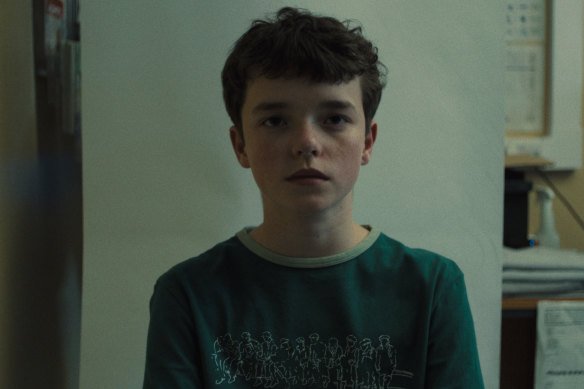Involuntary celibacy – “incel” – culture, toxic masculinity, knife crime and young teens on social media. Netflix series Adolescence has become a focal point for anxieties about the lost boys of the internet and, in doing so, it has attracted a record 66 million views in two weeks. British Prime Minister Keir Starmer has even suggested the show is important enough to be shown in parliament.
The series is four hours of harrowing watching, following the story of 13-year-old Jamie Miller, who is accused of murdering a 14-year-old girl with a knife. One rainy weekend, my nearly 13-year-old son and I watched it in a single day. He asked me to write this.
Owen Cooper plays Jamie Miller, who is arrested for murder, in the Netflix drama Adolescence.
It’s difficult, though compelling watching for a parent. The arrest with which the series begins emphasises the fragile shoulders and skinny torso of the accused young teen; a child really, taken into adult custody for a violent crime. Obviously, he should be protected by his parents. Obviously, he can’t be. It’s too late for that. Jamie has become part of a world the parents don’t understand. As the police seek a motive for the crime, Jamie’s loneliness in prison is only underscored by the loneliness of the outside and online worlds he had inhabited.
One of the investigating police officers even compares his school to a prison, in which the teachers are so stretched just trying to manage unruly inmates that learning is pretty much out of the question. Yet the main interaction of the teens isn’t in person but online; their bodies have become fleshy props in service of those cyber interactions. The girls send nudes to the boys. The boys share them to prove something – to themselves or others. Everyone is ranking everyone else, all the time.
The writers of the show want Adolescence to be an educational tool, a conversation-starter. “One of our aims was to ask, ‘What is happening to our young men these days, and what are the pressures they face from their peers, from the internet and from social media?’,” says co-creator Stephen Graham, who also plays the role of Jamie’s father. Instead, Adolescence has drawn a frame around a conversational void that is bigger than the writers seem to have realised.
The void is, as they might have hoped, being filled by cultural commentators. Academic and social scientist Dr Anthony Collins was invited onto a podcast by Gen-Z media outlet The Daily Aus to discuss incel culture in the context of the show. But Collins immediately pointed out that incel culture is incredibly uncommon among boys as young as Jamie, and is much more likely to arise in older teens or young men in their early 20s. He points out that Adolescence uses “incel” as a kind of “black box” to explain how a child from a loving family becomes a killer.
Keir Starmer holds a roundtable meeting with Sarah Simpkin from the Children’s Society and Adolescence co-writer Jack Thorne at 10 Downing Street.Credit: AP
My son and I also puzzled over that black box in discussing the series. It is unclear what exactly the process is, which is supposed to have taken Jamie, a character whom the writers take pains to depict as intelligent, from happy kid to “incel” killer. We know he saw a top half nude of Katie, the victim, which was being shared around the school. She’s judged as “flat”. We find out she’s bullied Jamie by calling him an incel, creating a pile-on on social media. Incel is a catch-all and a cop-out by the writers.
There is no examination of why Katie would send the nude to the boy and the social pressures driving young girls in their interactions with young boys. But this would have been a helpful question for the series to raise – among the most mystified are some of the boys who receive them. In real life, I know of a boy about that age who has been sent unsolicited sexy pictures of girls by the girls themselves (not nudes, but nearly).
Read the full article here
